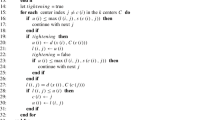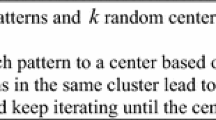Abstract
k-Means is a versatile clustering algorithm widely used in practice. To cluster large data sets, state-of-the-art implementations use GPUs to shorten the data to knowledge time. These implementations commonly assign points on a GPU and update centroids on a CPU.
We identify two main shortcomings of this approach. First, it requires expensive data exchange between processors when switching between the two processing steps point assignment and centroid update. Second, even when processing both steps of k-means on the same processor, points still need to be read two times within an iteration, leading to inefficient use of memory bandwidth.
In this paper, we present a novel approach for centroid update that allows us to efficiently process both phases of k-means on GPUs. We fuse point assignment and centroid update to execute one iteration with a single pass over the points. Our evaluation shows that our k-means approach scales to very large data sets. Overall, we achieve up to 20 × higher throughput compared to the state-of-the-art approach.














Similar content being viewed by others
Notes
We previously sketched our work as a two-page short paper [25].
Note that the Cross-Processing strategy uses the GPU for point assignment, whereas Single-Pass and Multi-Pass are executed on CPU only. Therefore we include the Cross-Processing strategy in both plots.
References
Amazon EC (2018) Amazon ec2 pricing. https://aws.amazon.com/ec2/pricing/on-demand. Accessed: 25 May 2018
Arthur D, Vassilvitskii S (2007) k‑means++: The advantages of careful seeding. In: ACM-SIAM, pp 1027–1035
Bai H et al (2009) k‑means on commodity GPUs with CUDA. In: WRI CSIE, pp 651–655
Breß S, Funke H, Teubner J (2016) Robust query processing in co-processor-accelerated databases. In: SIGMOD, pp 1891–1906
Breß S et al (2017) Generating custom code for efficient query execution on heterogeneous processors. CoRR abs/1709.00700
Cao F, Tung AKH, Zhou A (2006) Scalable clustering using graphics processors. In: WAIM, pp 372–384
Cassou C (2008) Intraseasonal interaction between the madden–julian oscillation and the north atlantic oscillation. Nature 455(7212):523–527
Che S et al (2009) Rodinia: a benchmark suite for heterogeneous computing. In: IISWC, pp 44–54
Dall M et al (2017) Arctic sea ice melt leads to atmospheric new particle formation. Sci Rep 7(1):3318
Elkan C (2003) Using the triangle inequality to accelerate k‑means. In: ICML, pp 147–153
Fang W et al (2008) Parallel data mining on graphics processors. Tech. Rep. HKUST-CS08-07, HKUST
Farivar R et al (2008) A parallel implementation of k‑means clustering on GPUs. In: PDPTA, pp 340–345
Fernando R (2004) GPU gems: programming techniques, tips and tricks for real-time graphics. In: Pearson higher education (chap 37.2)
Funke H et al (2018) Pipelined query processing in coprocessor environments. In: SIGMOD, ACM
Hall J, Hart J (2004) GPU acceleration of iterative clustering. In: GPGPU, pp 45–52
He B et al (2009) Relational query coprocessing on graphics processors. ACM Trans Database Syst. https://doi.org/10.1145/1620585.1620588
Heimel M et al (2013) Hardware-oblivious parallelism for in-memory column-stores. Proceedings VLDB Endowment 6(9):709–720
Heintzman ND et al (2007) Distinct and predictive chromatin signatures of transcriptional promoters and enhancers in the human genome. Nat Genet 39(3):311
Hellerstein J et al (2012) The MADlib analytics library or MAD skills, the SQL. Proceedings VLDB Endowment 5(12):1700–1711
Karnagel T, Müller R, Lohman GM (2015) Optimizing GPU-accelerated group-by and aggregation. In: ADMS, pp 13–24
Kleisner KM et al (2016) The effects of sub-regional climate velocity on the distribution and spatial extent of marine species assemblages. PLoS ONE 11:1–21
Lee S et al (2016) Evaluation of k‑means data clustering algorithm on intel xeon phi. In: BigData, pp 2251–2260
Li Y et al (2010) Speeding up k‑means algorithm by GPUs. In: IEEE CIT, pp 115–122
Lloyd S (1982) Least squares quantization in PCM. IEEE Trans Inf Theory 28(2):129–136
Lutz C et al (2018) Efficient k‑means on GPUs. In: DaMoN https://doi.org/10.1145/3211922.3211925
MacQueen J et al (1967) Some methods for classification and analysis of multivariate observations. In: Proc. Fifth Berkeley Symp. on Math. Statist. and Prob., vol 1, pp 281–297
Mhembere D et al (2017) knor: A NUMA-optimized in-memory, distributed and semi-external-memory k‑means library. In: HPDC
Müller I et al (2015) Cache-efficient aggregation: hashing is sorting. In: SIGMOD, pp 1123–1136
Nugteren C et al (2011) High performance predictable histogramming on GPUs: exploring and evaluating algorithm trade-offs. In: GPGPU, p 1
Nvidia (2017a) CUDA C programming guide. Tech. Rep. PG-02829-001_v8.0. http://docs.nvidia.com/pdf/CUDA_C_Programming_Guide.pdf. Accessed: 20 Jan 2017
Nvidia (2017b) Tuning CUDA applications for maxwell. Tech. Rep. DA-07173-001_v9.0. http://docs.nvidia.com/cuda/pdf/Maxwell_Tuning_Guide.pdf. Accessed: 20 Jan 2017
Passing L et al (2017) SQL- and operator-centric data analytics in relational main-memory databases. In: EDBT, pp 84–95
Pirk H, Manegold S, Kersten ML (2014) Waste not…efficient co-processing of relational data. In: ICDE, pp 508–519
Pirk H et al (2016) Voodoo – A vector algebra for portable database performance on modern hardware. Proceedings VLDB Endowment 9(14):1707–1718
Sanderson C, Curtin R (2016) Armadillo: a template-based c++ library for linear algebra. J Open Source Softw. https://doi.org/10.21105/joss.00026
Shalom A, Dash M, Tue M (2008) Efficient k‑means clustering using accelerated graphics processors. In: DaWaK, pp 166–175
Shindler M, Wong A, Meyerson AW (2011) Fast and accurate k‑means for large datasets. In: NIPS, pp 2375–2383
Sitaridi EA, Ross KA (2013) Optimizing select conditions on gpus. In: DaMoN, p 4
Stehle E, Jacobsen H (2017) A memory bandwidth-efficient hybrid radix sort on GPUs. In: SIGMOD, pp 417–432
TPC-H (2017) Transaction processing performance council. http://www.tpc.org/tpch. Accessed: 29 Sep 2017
Vitak SA et al (2017) Sequencing thousands of single-cell genomes with combinatorial indexing. Nat Methods 14(3):302
Wu F et al (2013) A vectorized k‑means algorithm for intel many integrated core architecture. In: APPT, pp 277–294
Zang C et al (2016) High-dimensional genomic data bias correction and data integration using mancie. Nat Commun 7:11305
Zhang T, Ramakrishnan R, Livny M (1996) Birch: an efficient data clustering method for very large databases. In: SIGMOD, pp 103–114
Acknowledgements
This work was funded by the EU projects SAGE (671500) and E2Data (780245), DFG Priority Program “Scalable Data Management for Future Hardware” (MA4662-5), and the German Ministry for Education and Research as BBDC (01IS14013A).
Author information
Authors and Affiliations
Corresponding author
Rights and permissions
About this article
Cite this article
Lutz, C., Breß, S., Rabl, T. et al. Efficient and Scalable k‑Means on GPUs. Datenbank Spektrum 18, 157–169 (2018). https://doi.org/10.1007/s13222-018-0293-x
Received:
Accepted:
Published:
Issue Date:
DOI: https://doi.org/10.1007/s13222-018-0293-x




